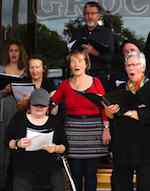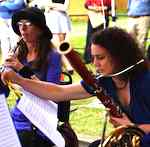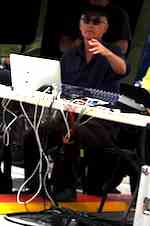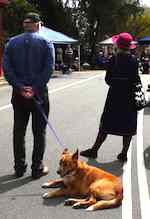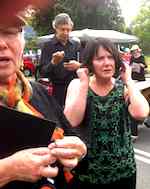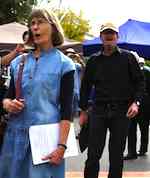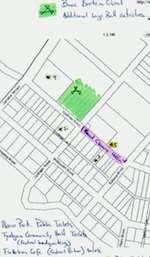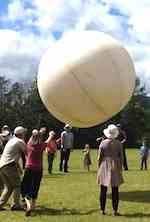 | |||||||

|
Singing Up Tyalgum a project from jon rose |
|
|
Video extract of The Tyalgum Sing Up here. Audio extracts of The Tyalgum Sing Up including the final section where humans mimic birds here Extract from Wind quintet parts of The Tyalgum Sing Up here If we are in the middle of the 6th great extinction as many commentators suggest, it may already be too late to act in any altruistic sense. But we could act out of base self-interest, a sense for survival, in this respect it is never too late to learn, and to learn from an Aboriginal culture that has defied the odds. The bones and cremated ashes of Lake Mungo man and woman are 42,000 years old. The footsteps uncovered along a previous fertile lake are 20,000 years old, before the last Ice Age. These footprints (recently read by trackers from central Australia) show an ancient vibrant life of connectivity. And if we as white-fellas are finally to "get it" with regard to our dependence on planet Earth, then we too have to enter into a kinship of connectivity that encompasses all biodiversity - linking homo sapiens into past and present; as the Arrernte say "every hill got a story". Traditionally this manifests itself as a total cosmology (law), down to knowing the specific songs for every aspect of life, death, myth, geography, ceremony, journey, animal being, or common artefact. With this in mind, we might yet re-discover a function for the practice of music. Despite the attempted trashing of their entire cultures, Aboriginal people still hang onto the notion of "singing up country". It's always a two way context, unlike the one way process for most European music where there are the doers and the done to. As Debbie Bird Rose suggests "Singing up is work that fosters encounter and promotes flourishing relationships. In Singing up the country or singing up the others (other living beings), one is singing oneself into the world of life, and singing the world of life into greater complexity." (Wild Dog Dreaming: Love and extinction). Singing up can be as utilitarian as singing up the local pharmacy (the finding of specific wild herbs for certain ailments) or as the most powerful of supernatural drugs in the life and death narrative - singing someone to death (a recent example of this happened on Palm Island: a police officer allegedly involved in an aboriginal death in custody was "sung" by senior members the community looking for "pay back" in indigenous legal terms). We are unlikely to ever recover that power of music that needs the universe to be sung into existence every day, but maybe we can try to incorporate such a resonance in our creative practice. Before 1788, all music took place outside cheek by jowl with the environment.. Singing Up Tyalgum (12th September 2015) was an attempt to start such a process and was set up as a community project. This involved professional musicians, students, and anyone who wished to be involved whether skilled up or not. There would also be no time for a full rehearsal. The project required a language that was relevant and that could be distilled or simplified into discrete phrases that would function in unpredictable circumstances (it was unknown how many people would finally be involved). For the past decade, Dr. Hollis Taylor has been recording and analysing the music of The Pied Butcher bird - a unique Australian species, that is probably some six million years old, and comes with virtuosic abilities. Each bird develops its own repertoire that tends to change from year to year - a song may last 30 minutes or over 7 hours. There is a common species call, extraordinary melodic invention, and the ability for mimicry - for which no one has yet figured out an answer to the "why" question. It is a reasonable supposition to suggest that we "got music" by mimicking the birds. Pied Butcher birds are found in many parts of Australia and in Tyalgum. The following are the performance notes given to all those taking part: Singing Up Tyalgum. Singing Up Tyalgum situates itself somewhere between a music performance, a celebration of place, a sound installation, an interspecies seminar, and a community event (happening). By nature of it being a community event, all are invited to contribute, particularly if they can sing or play a musical instrument. All and any skill levels are encouraged. There are also options for those who enjoy making music but don't necessarily read it. Because there is no time to facilitate a rehearsal for a traditional style performance, we ask all who want to be involved to assemble on Coolman Street in front of the general store at 11.30 am to find out how it all works, make some sound checks, and try out some sections of the Sing Up - so we can get comfortable with the material and process. We will have a short 5-minute break before launching into it at 12.30 - the performance running till 13.15. Singing Up Tyalgum is divided into 11 sections. Each section will be indicated by a large card with a number written on it (SingUp1, SingUp2, SingUp3, etc). When the new card is shown, it means we have moved onto that section. If you are still performing something, finish what you are doing (with either a fade out or a cut) and get ready for the new section. There is no panic or hurry; if you are a conductor, just indicate to your group that we have moved into the new section. Each section lasts anything from 3-6 minutes. Sections 1-10 follow the same format and process. Each section always starts with a recording of a pied butcherbird singing; when this is happening there should be nothing else going on - it is a time to listen - not perform. Once the song is established by the bird, different groups - choir, wind quintet, string quartet, large band (wind and brass), percussion duo - are invited by main conductor (Jon rose) to enter into the mix. Each group has its own independent group conductor who then gives cues, tempo, dynamics). Please pay attention to repeating the notation for each section as many times as indicated. Section 11 (final section) works differently to the previous sections, it involves the use of MP3 headsets for playback and vocal imitation. 1. Put on MP3 player, press go, adjust volume. You are listening to an 8 minute 44 second extract of a Pied Butcher Bird Song recorded by Hollis Taylor on the 27/8/2014 - recorded at Owen Springs (near Alice Springs). The original song lasted 76 minutes and it began at 5.20 in the morning. There are two other Pied Butcherbirds in the distance and a cuckoo joins in for a while halfway through. Some of the MP3s will have recordings of other avian species available for our human mimicry. If you can't get your hands on an MP3 player, just copy or mimic somebody else who has. 2. Leave your position, start walking up and down Coolman Street and surrounds, listen to a phrase and repeat it once by singing, whistling, or humming. No instruments please. You can listen to phrases and pick and choose which ones you wish to repeat or not. Most birds are very considerate musicians, and they commonly sing a phrase and follow it with a gap of a few seconds - enough time for us humans to listen and repeat! 3. You can also listen to the harmonic implications of the bird's song and sing sustained pitches (it's a C Major 7th chord). 4. Please spread out as far as you like, or you may prefer to remain in a huddle and sync up with others who sound like they are singing phrases at the same time as yourself. 5. When the recording stops. Please stop and hand your MP3 player into Jon Rose. Thank you! Most of the transcriptions of pied butcherbird songs have been simplified for ease of performance; however, sometimes there may be up to six sets of different materials (from each of the 6 sub-groups) being performed - so things could get quite complicated - just as a morning chorus is intricate and complicated! If we keep concentrated on rendering clearly our own particular material - it will work. Finding the right timing and space for it within the available acoustic space will be the main pre-occupation of each of the group conductors. In general the material is to be considered as canonic, antiphonal, and part of an overall counterpoint. Overlapping of material will happen but try to keep an independent line and not to synchronize with any other group unless you have been asked to do so (e.g. band and percussion sometimes sync up). We will also have some space between each group for ease of hearing, as we are able to use a large section of Coolman Street in Tyalgum. The audience will be able to move around and create their own mix of the various sonic events and processes. If you want to be part of The Sing Up, please bring a solid music stand, some clothes pegs (against the vagaries of the wind), and your own chair (if you need one). Performers: Lunaire Collective Hollis Taylor and Ironwood String Quartet The Song Company Members of Vox Caldera David Wellman and community band Martha Baartz and students Clocked Out Tyalgum festival audience Len and Wendy McPherson technical production Anna McMichael festival director Eve Newsome festival director www.jonroseweb.com |
 |

